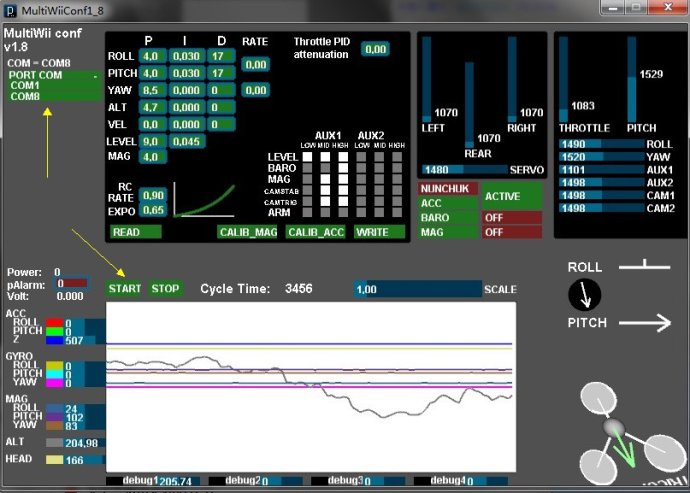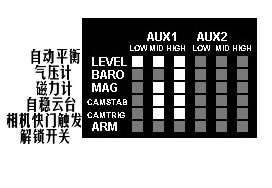FTDI 驱动在arduino-0022.zip包里 解压缩后的目录是 \arduino-0022\drivers\FTDI USB Drivers
【注意:需要先插入FTDI到电脑的USB 按提示搜索驱动后安装驱动即可】
如果您是WINDOWS系统用户 那么请先安装JAVA插件
http://www.java.com/zh_CN/download/windows_ie.jsp?locale=zh_CN 安装即可
【注意:需要连接网络才可以安装此安装文件】
目录application.windows
执行MultiWiiConf*_*.exe【版本不同文件名不同】
运行GUI调试软件的时候必须关闭 arduino-0022 因为FTDI不能同时运行在两个程序里。
首先连接好飞控和FTDI、接收机运行GUI软件
 如上图 先选择FTDI的COM口 然后 点击START 开始 在点击READ 读取飞控数据!
如上图 先选择FTDI的COM口 然后 点击START 开始 在点击READ 读取飞控数据!

首先是遥控器摇杆正反向检查和舵量调整。打开遥控器。看上图
1、推油门【THROTTLE状态条向上运动】收油门【THROTTLE状态条向下运动】2、推俯仰【PITCH 状态条向上运动】 拉俯仰【PITCH 状态条向下运动】
3、副翼打左边【ROLL 状态条向左运动】 副翼打右边【ROLL 状态条向右运动】
4、方向舵打左边【YAW 状态条向左运动】 方向舵打右边【YAW 状态条向右运动】
5、如果您接收机与飞控连接了AUX1为某开关通道,请拨动此开关注意GUI里的AUX1状态条同样有变化。
以上操作如果出现反向的请您设置遥控器通道反向以实现上面的动作要求。
其次就要调整遥控器的舵量。
1、当所有通道在中立点的时候查看GUI窗口里数值是不是在1500左右【数值偏差+ - 5】
2、当所有通道在最低点的时候查看GUI窗口里数值是不是在1095左右【数值偏差+ - 5】
3、当所有通道在最高点的时候查看GUI窗口里数值是不是在1905左右【数值偏差+ - 5】
如果您在操作遥控器摇杆的时候,不是以上数值请您修改遥控器舵量设置并达到以上动作要求。
下面是对传感器的校准
 如上图 校准飞控各个传感器 【飞控板或者飞机水平放置 然后分别点击 CALIB_ACC CALIB_MAG
如上图 校准飞控各个传感器 【飞控板或者飞机水平放置 然后分别点击 CALIB_ACC CALIB_MAG 点击CALIB_ACC 10秒后加速度传感器校准成功。 再点击CALIB_MAG 后有你有30秒来旋转电路板, x,y,z轴至少360度 这时飞控板LED1灯闪烁,闪烁停止三轴电子罗盘校准完成】
 如上图 设置AUX1 遥控接收第5通道连接主板AUX1
如上图 设置AUX1 遥控接收第5通道连接主板AUX1然后依据上图所示 根据个人需要 设置 5通3段开关分别对应的功能
【点白为功能开启,选好后 需要点WRITE 写入数据,然后在点 READ确认是否写入成功】
 如上图
如上图RC rate: 定义pitch 和 roll 遥控器灵敏度, 如果感到反应太灵敏, 减小该值。如果想增加pitch 和 roll 遥控器灵敏度,增大该值。
RC expo: 定义PITCH 和 ROLL 遥控器摇杆中心点平滑区域, 该功能可以同时提高遥控精确度和幅度。
【一般的遥控器也可以实现该功能,但是最好用上述参数来设置】
 如上图设置各个参数的PID数值
如上图设置各个参数的PID数值{RATE 不是用来增加稳定性而是增加操控性 0.00= 初学者(FPV 或航拍) 0.40-0.70 是特技模式 1.00是空翻模式,如果不擅长飞行,请设置为0.00。}
该数值可以实现大油门状态下爬升的稳定性。如果不擅长飞行,请设置为0.00。
【注意:用鼠标点住需要调整的数字左右移动修改】
【网络搜集】PID三个参数的直观作用:
- P(比例):这是一个增益因子,当多轴飞行器受风等的影响发生向一边倾斜时,P值直接决定多轴飞行器的抵抗这种倾斜的力的大小。P越大,多轴飞行器抵抗意外倾斜的能力越强,但P过于大时会引起多轴飞行器抖动甚至猛烈侧翻。P越小,多轴飞行器抵抗意外倾斜的能力越弱,但P过小时会引起多轴飞行器自平衡能力不足甚至朝一边侧翻(如顺着风的方向)。
- I(积分):这个参数决定了飞行控制器对过往飞行状态的依赖程度。如果I值太小,会使飞行器过度依赖当前的误差,不能抑制“过敏”现象,从而造成飞行颠簸;如果I值太大,则会过度削弱系统对误差的反应能力,造成反应迟缓。
- D(微分):一旦多轴飞行器发生倾斜,则认为多轴飞行器会继续向同一方向倾斜,合适的D参数的能有效抑制未来可能发生的倾斜。如果D值太小,您会觉得多轴飞行器反应不够灵敏;如果D值太大,也会引起“过敏”。相较于P而言,D反映得更多的是灵敏度,而P反映的是纠正误差的力度。
----------------------【模友人間失格翻译整理】-----------------------
MultiWii飞行器的PID调试原理和配置指南
(注意:此指南仍在完善中)
Proportional-Integral-Derivative
比例(P)-积分(I)-微分(D)
当飞行器在Pitch/Roll/Yaw*这三轴中有任何方向的改变,陀螺仪将输出一个相对初始位置的偏差量,飞控板接收此偏差量并通过PID算法程序,控制电机的输出使飞行器回到初始位置.
偏差量的数据组合,基本上是过去的变化值和对未来变化的预测值,这为飞控板提供了足够的信息控制电机,使飞行器回到平衡的状态
(*Pitch-俯仰 Roll-横滚 Yaw-方向)
P是PID三者中最主要的部分
在地面的基本PID参数调试
将PID参数还原为默认值
小心并牢固的使飞行器腾空(比如抓在手中)
增加油门,使电机启动,开始感觉到升力
让飞行器往每个电机的方向倾斜一次,你应该感觉到有反作用力在阻止你使飞行器倾斜
改变P的大小,直到使随意倾斜飞行器变得困难(没打开自稳时,飞控板会允许姿态呈现斜度,这是正常的)
现在,尝试着摇晃飞行器.增大P直到出现抖动,然后减小一点
重复上述动作调试好Yaw轴
现在飞行器的参数已经适合进行试飞调试了.
高级调试部分-对P.I.D的理解
P-纠正飞行姿态回到初始平衡位置的力量大小.
力量的大小与初始位置的偏差值减去接收机信号发出的控制趋向呈比例关系*
一个较高的P值会造成一个较大的力抵抗飞行器偏离平衡状态
如果P值过高,在飞行器回中时,会修正过量,使飞行器需要再次反向修正补偿,这会导致飞行器来回晃动直到重新平衡,或者持续晃动并增大幅度直到失去平衡
增大P值:
飞行器将更加稳定,直到P值过高,出现抖动并失去控制
需要注意:飞行器的任何位移都会有非常大的力进行修正
减小P值:
飞行器将会开始偏移,直到P值过低,飞行器变得非常不稳定
当改变方向时,修正的力更小
特技飞行:需要略高的P值
普通平飞:需要略低的P值
I-对初始偏差值进行采样和取平均值的时间周期长度
I值使修正偏差的力有一个过程,延长了偏差存在的时间,此时力随着时间增长,直到达到力的最大值
一个比较高的I值可以增加航向的稳定性
增大I值:
增加稳定保持在平衡位置的能力和减小漂移,但同时会降低回中的反应速度,
会降低P的效果
减小I值:
会增快对变化的反应速度,但同时会增大漂移和降低保持平衡的能力
会增加P的效果
特技飞行:需要略低的I值
普通平飞:需要略高的I值
D-飞行器回到平衡的速度
一个较高的D值(此参数与其数字相反,高D值意味着数字反而小,比如一个接近0的数)将会使飞行器以非常快的速度回到平衡
增大D值(即减小数字):
更快的回中速度,同时大大增加修正过量和抖动的几率
会增加P值的效果
减小D值:
回中速度变慢,同时导致回中过程中的抖动(不同于修正过量的抖动)
会降低P值的效果
特技飞行:增大D(即减小数字)
普通平飞:减小D(即增大数字)
高级调试部分-实际应用
(仅供参考)
关于PID的设置 下面是英文原文
PID tuning theory and configuration guide for MultiRotorCraft
(CAVEAT- this is STILL under construction - feedback is wanted / needed)
Proportional-Integral-Derivative
When the MultiRotor orientation is changed in any pitch/roll/yaw axis, the gyros indicate an angular change from it's initial position.
The MultiRotor controller records the original position and by utilising a "PID" program loop, drives the motors to attempts to return the MultiRotor to its initial position.
This is done my a combination of the measured angular deviation, sampling the change over time and predicting the future position. This provides enough information for the controller to drive the motors to return equilibrium.
P is the dominant part of PID and gets you in the ballpark for good flight characteristics.
Basic PID Tuning - on the ground
Set PID to the designers default recommended settings
Hold the MulitiRotor securely and safely in the air
Increase throttle to the hover point where it starts to feel light
Try to lean the MultiRotor down onto each motor axis
You should feel a reaction against your pressure for each axis.
Change P until it is difficult to move against the reaction. Without stabilisation you will feel it allow you to move over a period of time. That is OK
Now try rocking the MultiRotor. Increase P until it starts to oscillate and then reduce a touch.
Rrepeat for Yaw Axis.
Your settings should now be suitable for flight tuning.
Advanced Tuning - understanding impact of P, I and D
P - this is the amount of corrective force applied to return the MultiRotor back to its initial position.
The amount of force is proportional to a combination of the the deviation from initial position minus any command to change direction from the controller input.
A higher P value will create a stronger force to resist any attempts to change it's position.
If the P value is too high, on the return to initial position, it will overshoot and then opposite force is needed to compensate. This creates an oscillating effect until stability is eventually reached or in severe cases becomes completely destabilised.
Increasing value for P:
It will become more solid/stable until P is too high where it starts to oscillate and loose control
You will notice a very strong resistive force to any attempts to move the MultiRotor
Decreasing value for P:
It will start to drift in control until P is too low when it becomes very unstable.
Will be less resistive to any attempts to change orientation
Aerobatic flight: Requires a slightly higher P
Gentle smooth flight: requires a slightly lower lower P
I - this is the time period for which the angular change is sampled and averaged.
The amount of force applied to return to initial position gets is increased the longer the deviation exists until a maximum force value is reached
A higher I will increase the heading hold capability
Increasing value for I:
Increase the ability to hold overall initial position and reduce drift, but also increase the delay in returning to initial position
Will also decrease the importance of P.
Decreasing value for I:
Will improve reaction to changes, but increase drift and reduce ability to hold position
Will also increase the importance of P.
Aerobatic flight: Requires a slightly lower I
Gentle smooth flight: Requires a slightly higher I
D - this is the speed at which the MultiRotor is returned to its original position.
A higher D (as it is negative value this means a lower number - i.e. closer to zero) will mean the MultiRotor wil snap back to its initial position very quickly
Increasing value for D: (remember, that means a LOWER number as it is a negative value)
Improves the speed at which deviations are recovered
With fast recovery speed comes a higher probability of overshooting and oscillations
Will also increase the effect of P
Decreasing value for D: (remember, that means a HIGHER number as it is a negative value - i.e. further from zero)
Reduces the oscillations when returning any deviations to their initial position
Recovery to initial position becomes slower
Will also decrease the effect of P
Aerobatic flight: Increase D (remember, that means a LOWER number as it is a negative value - i.e. closer to zero)
Gentle smooth flight: Decrease D (remember, that means a HIGHER number as it is a negative value - i.e. further from zero)
Advanced Tuning - practical implementation
(at this moment - these are proposals only!)
For Aerobatic flying:
Increase value for P until oscillations start, then back of slightly
Change value for I until until hover drift is unacceptable, then increase slightly
Increase value for D (remember, that means a LOWER number as it is a negative value - i.e. closer to zero) until recovery from dramatic control changes results in unacceptable recovery oscillations
P may now have to be reduced slightly
For stable flying (RC):
Increase value for P until oscillations start, then back of slightly
Change value for I until recovery from deviations is unacceptable, then increase slightly
Decrease value for D (remember, that means a HIGHER number as it is a negative value - i.e. further from zero) until recovery from dramatic control changes becomes too slow. Then Increase D slightly (remember - lower number!)
P may now have to be reduced slightly
For stable flying ( AP / FPV):
Increase value for P until oscillations start, then back of slightly
Change value for I until recovery from deviations is unacceptable, then increase slightly
Decrease value for D (remember, that means a HIGHER number as it is a negative value - i.e. further from zero) until recovery from dramatic control changes becomes too slow. Then Increase D slightly (remember - lower number!)
P may now have to be reduced slightly
You will have to accept a compromise of optimal settings for stable hover and your typical mode of flying. Obviously factor it towards your most common style.
Other factors affecting PID
Taking known good PID values from an identical configuration will get you close, but bear in mind no two MultiRotors will have the same flying characteristics and the following items will have an impact on actual PID values:
Frame weight /size / material / stiffness
Motors - power / torque /momentum
Position - Motor-->motor distance
ESC / TX - power curves
Prop - diameter / pitch / material
BALANCING
Pilot skills
References